In 2012, California businessman Russ George illegally dumped 120 tons of iron sulfide over a 25,000 kilometer (15,000 mile) square area off the British Columbia coast in order to create a massive algae bloom to feed Pacific fish and increase catches. Now, salmon runs are setting a new records to the tune of an added 100,000 tons, and the results have been hailed a “a stunningly over-the-top success” in addition to being criticized by more wary environmental groups.
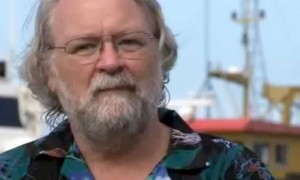
Russ George initiated the precedent-setting iron sulfide test in July 2012. The test involved a geoengineering technique called ocean fertilization, whereby plankton are nourished with carbon dioxide–a source of nutrition which has decreased by 25 percent in recent decades. Russ George hoped to gain lucrative carbon credits from the project.
Iron commonly reaches offshore algae by being blown into the sea by dust storms on land, and sometimes iron enrichment occurs naturally, such as after the 2008 eruption of the Kasatochi volcano in Alaska, which spewed mineral-rich ash into the Northeast Pacific Ocean salmon pasture, causing the 2010 “volcano miracle salmon run.”
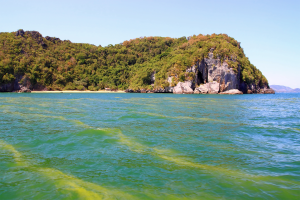 Iron nourishes the marine food cycle from the ground up, directly feeding zooplankton, which feed young salmon, which in turn feed larger fish and sea mammals.
Iron nourishes the marine food cycle from the ground up, directly feeding zooplankton, which feed young salmon, which in turn feed larger fish and sea mammals.
Some of the waters that George seeded with iron, in the words of Timothy Parsons, professor emeritus of fisheries science at the University of British Columbia, were so nutrient-poor as to be a “virtual desert dominated by jellyfish.”
The iron sulphide was applied thinly from a fishing boat in an eddy 370 kilometers (200 miles) off the Haida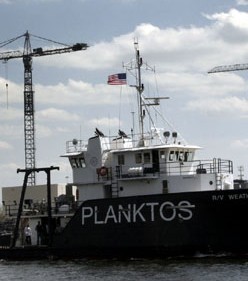 Gwaii/Queen Charlotte Islands, after George convinced the Old Masset village council to establish the Haida Salmon Restoration Corporation (HSRC) and offered to fund the
Gwaii/Queen Charlotte Islands, after George convinced the Old Masset village council to establish the Haida Salmon Restoration Corporation (HSRC) and offered to fund the 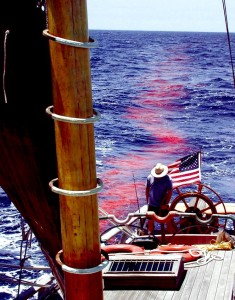 project with $1 million of his own money. The corporation was also funded by $2.5 borrowed money from a Canadian credit union. The area covered by the dump was 25,657 km square, roughly the size of Lake Erie.
project with $1 million of his own money. The corporation was also funded by $2.5 borrowed money from a Canadian credit union. The area covered by the dump was 25,657 km square, roughly the size of Lake Erie.
Evidence of the massive artificial plankton bloom has been provided by satellite images. The bloom is as large as 10,000 km square–10 times larger than any previous test.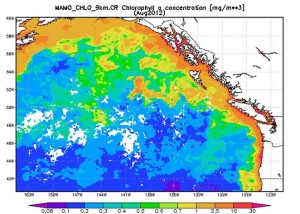
Although the dump was illegal under Canadian Law (due to its scale) and United Nations resolutions (See here, here and here) , and although the Canadian government raided the headquarters of the offices of HSRC and George was compelled to resign from the HSRC presidency, recent evidence has suggested that the Canadian government may have known about the geoengineering scheme, but not stopped it.
George said of the project, “Let’s not make this a story all about CO2 and Carbon… it’s really about whether the ocean pastures come back to the abundance of life that they and we enjoyed 100 years ago. My hypothesis is that if we can help replenish and restore the ocean pastures we will see the results in the one thing that mankind is most connected to the ocean by, it’s FISH!
“Indeed my experiment, which at a size of 30,000+ sq. km. is perhaps the largest single experiment of its kind ever conducted, has demonstrated that the fish come back in incredible abundance, quickly… All species of fish have responded but the best data comes from those fish who swim back to us instead of making us go hunt them down.”
It appears that fish catches in the area have increased massively. It is estimated that the dump boosted catches by over 100,000 tons.
The largest run of Pink salmon–which take two years to mature–occurred 12-20 months after the iron seeding project took place.Salmon are able to grow bigger in rich environments and more frequently reach catchable size. In a rich ocean environment, salmon can gain more than one pound per month, it has been reported.
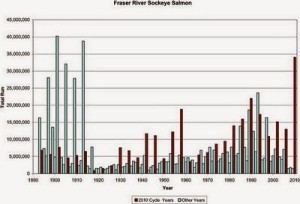 In the northeast Pacific Ocean, salmon catches more than quadrupled–from 50 million to 226 million–and in BC’s Fraser River, where catches only once exceeded 25 million, 72 million fish were caught.
In the northeast Pacific Ocean, salmon catches more than quadrupled–from 50 million to 226 million–and in BC’s Fraser River, where catches only once exceeded 25 million, 72 million fish were caught.
The Alaska Department of Fish and Game recently completed an assessment of the 2013 commercial salmon fishery. With the record pink salmon harvest of 219 million fish, the 2013 harvest ranks as the second most valuable on record. In 2013 the value of the Pink harvest was $691.1 million, below only the 1988 harvest value of $724 million. The total number of salmon harvested also set a new record at 272 million fish, well above the expected 50
million. .
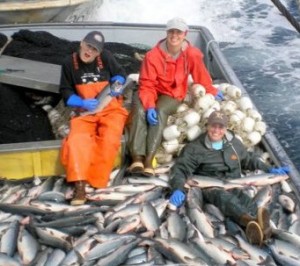 This years Fraser River Sockeye salmon run is projected to be at a record high as well–twice the previous record set in 1900. Up to 72 million Sockeye are expected. In history, the number has not exceeded 45 million.
This years Fraser River Sockeye salmon run is projected to be at a record high as well–twice the previous record set in 1900. Up to 72 million Sockeye are expected. In history, the number has not exceeded 45 million.
Some have hailed the project as a boon, such as leading sustainability media outlet Treehugger, who said George’s results “had truly amazing, positive impact,” and Robert Zubin, who in a piece for the National Review called the experiment “a stunningly over-the-top success.”
Other environmentalists have targeted the Haida First Nations and George for tampering with the marine environment.
“It appears to be a blatant violation of two international resolutions,” said senior high-seas adviser for the International Union for Conservation of Nature Kristina Gjerde. “Even the placement of iron particles into the ocean, whether for carbon sequestration or fish replenishment, should not take place, unless it is assessed and found to be legitimate scientific research without commercial motivation. This does not appear to even have had the guise of legitimate scientific research.”
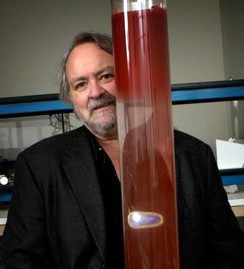
“It is now more urgent than ever that governments unequivocally ban such open-air geoengineering experiments,” said Silvia Ribeiro, of the international anti-technology watchdog ETC Group. “They are a dangerous distraction providing governments and industry with an excuse to avoid reducing fossil-fuel emissions.”
One of the witnesses to an unprecedented 2012 orca group sighting commented, “If Mr. George’s account of the mission is to believed, his actions created an algae bloom in an area half of the size of Massachusetts that attracted a huge array of aquatic life, including whales that could be ‘counted by the score.’ . . . I began to wonder: could it be that the orcas I saw were on the way to the all you can eat seafood buffet that had descended on Mr. George’s bloom? The possibility . . . provides a glimpse into the disturbing repercussions of geoengineering: once we start deliberately interfering with the earth’s climate systems — whether by dimming the sun or fertilizing the seas — all natural events can begin to take on an unnatural tinge. . . . a presence that felt like a miraculous gift suddenly feels sinister, as if all of nature were being manipulated behind the scenes.”
Specific criticisms of the project include an idea of “ocean dead zones,” which result from too much plankton. George has responded to this criticism by saying that iron seeding “can only work in regions of the ocean far out to sea and where the water is miles deep… such locations are as different from the shallow near shore regions where ocean dead zones exist as are grasslands and mountain tops… .”
Another criticism is that the nourishment may create toxic blooms and “domoic acid.” George has responded to this criticism by saying that previous blooms in many areas did not cause such a feature in the ocean.
By James Haleaby
Alaska Department of Fish and Game
Haida Salmon Restoration Corporation/Simon Fraser University
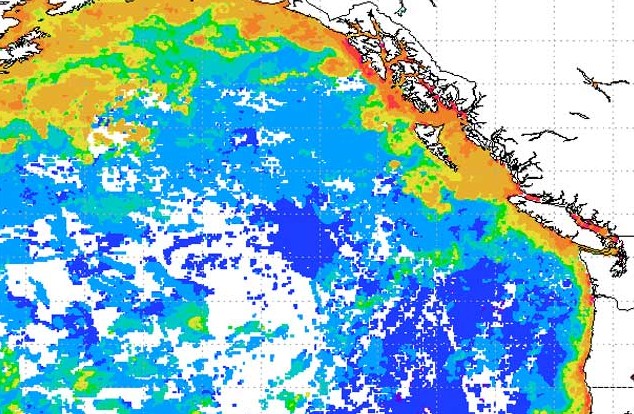
If carbon is shifted from carbonic acid (dissolved in sea water) to the food chain and thereby sequestered in consumable flesh (for people and whales) that is bad? \\
Ms Bethune, your hypothetical ‘if this and then iron in seas bad’ stipulation is a rhetorical manipulation and you know it. There is no evidence whatsoever anywhere that fertilizing the oceans will lead to more carbon pollution. Goodness, have you even read the projections for international carbon emissions over next decade? They are projected to increase dramatically with NO ATTACHMENT to iron fertilization.
Talk about a weak argument.
Comment courtesy Claudette Bethune, which was published on a discussion on another site. The Speaker asked permission to post this comment here, to provide additional weight and substance to the opposing side of the conversation surrounding marine geoengineering. Thanks again, Claudette…
Stanford has examined this, and it does not seem to result in a net benefit: “In the context of a carbon-emission offset scheme, ocean iron fertilization could lead to further acidification of the deep ocean without mitigating surface ocean chemistry change. Small-scale fertilization experiments can be useful to help understand the role of nutrients in the marine biogeochemical cycles. However, as suggested by our simulations ocean iron fertilization is unlikely to be effective for either climate or ocean chemistry mitigation. If ocean iron fertilization is implemented in generating carbon which lead to a corresponding increase in fossil-fuel emissions, it would cause further pollution to the deep ocean without conferring any environmental benefit.”
http://web.stanford.edu/~longcao/Cao&Caldeira(2010).pdf
This too: http://www.cbd.int/doc/publications/cbd-ts-45-en.pdf